How to Grow Asparagus
Asparagus is a hardy perennial that can produce fresh spears for decades when given proper care.

Known for its early spring harvest, asparagus offers a rewarding yield for the patient gardener. It requires a few years to establish fully.
To begin, choose a sunny location in your garden with well-drained soil. Preparing an asparagus bed involves creating a trench and ensuring nutrient-rich soil for the asparagus crowns to thrive in.
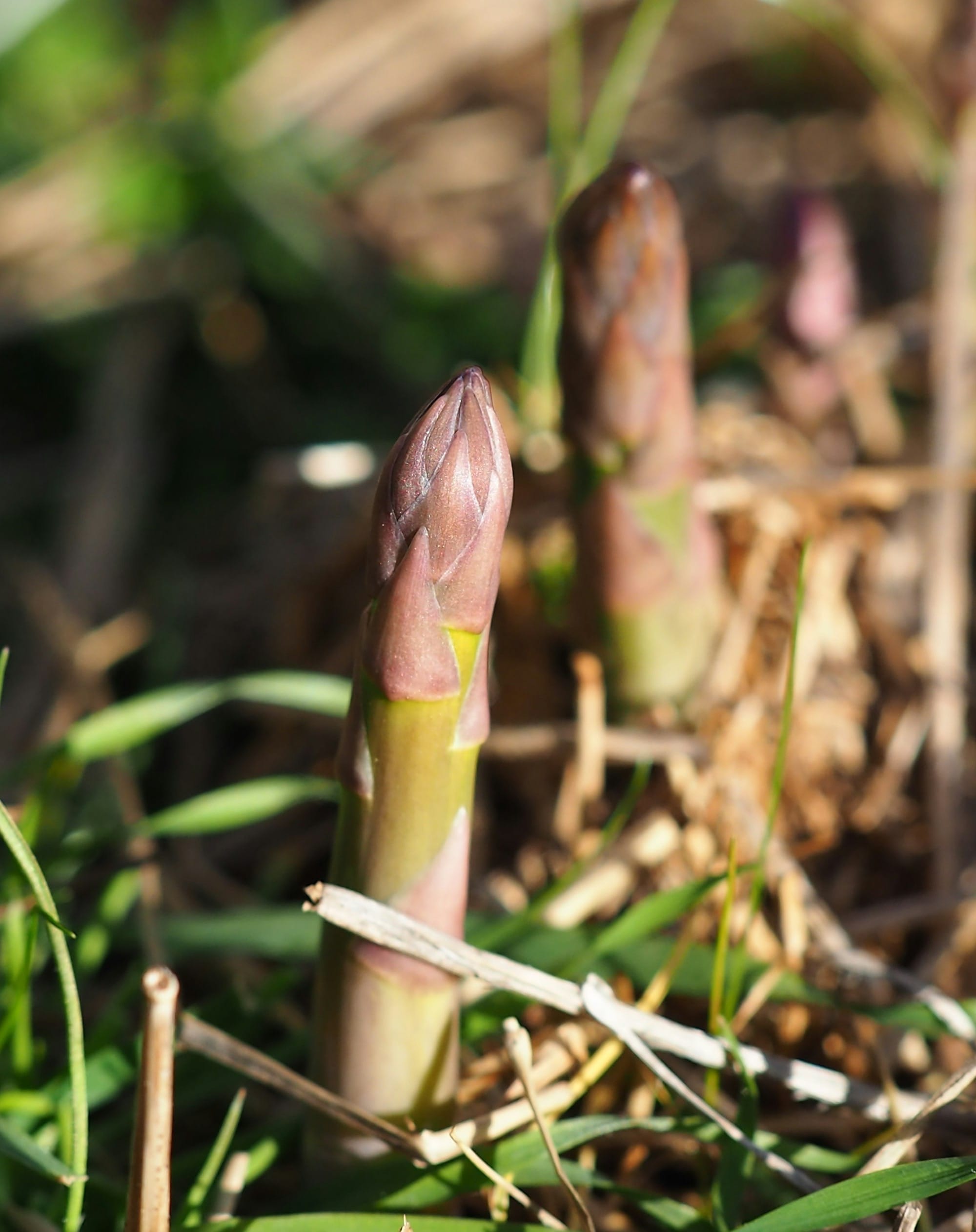
Planting asparagus crowns properly is vital for a healthy asparagus patch. The crowns should be planted in a trench approximately six inches deep with ample spacing to allow for growth.
As the plants mature, gradually backfill the trench with soil. Once established, consistent care, including watering, mulching, and weeding, supports robust plant growth.
Protecting asparagus from pests and diseases is also crucial, so regular monitoring is necessary.
Key Takeaways
- Asparagus requires well-prepared beds and several years to establish.
- Proper crown planting and trench backfilling are essential for growth.
- Regular care and pest management are key to a successful asparagus yield.
Understanding Asparagus
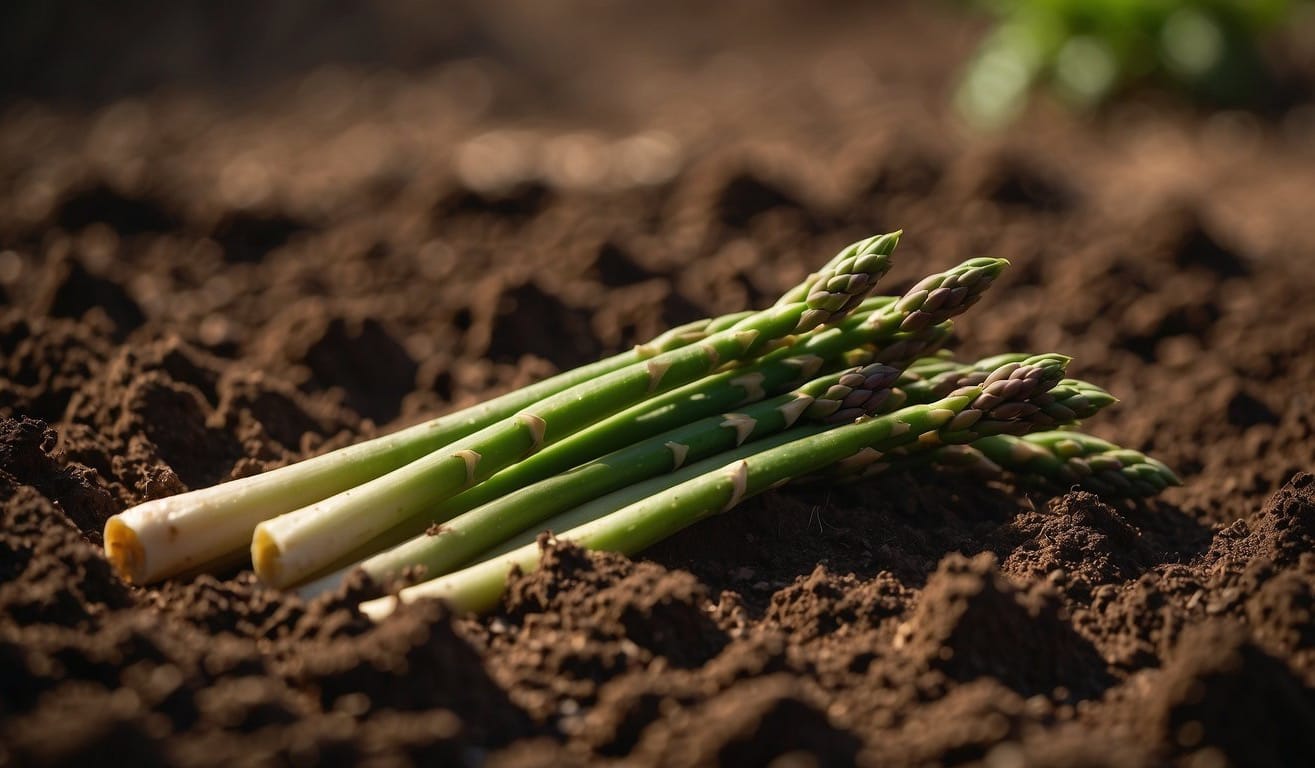
Before you embark on growing asparagus, it's important to recognize the different varieties available, the plant's structure, and the distinction between male and female plants.
Varieties of Asparagus
Hybrid Varieties:
- Jersey Knight: High yield, disease-resistant, primarily male plants.
- Jersey Giant: Cold-tolerant, predominantly male variety.
- Millennium: Developed in Canada, hearty and robust.
Heirloom Varieties:
- Mary Washington: A traditional variety, it produces both male and female plants.
- Purple Passion: Known for burgundy-colored spears that turn green when cooked.
Anatomy of Asparagus Plants
Asparagus plants are made up of several key parts:
- Crown: The root system from which the spears emerge.
- Spears: The edible part of the plant which, if left unharvested, becomes a fern.
- Ferns: The leafy, non-edible part of the plant that appears after the harvest period and helps photosynthesis to store energy for the next season.
Male vs Female Plants
- Male Plants: Produce more spears and are often more robust as they don't allocate resources to seed production.
- Female Plants: Tend to have thinner spears and produce red berries containing seeds.
It's imperative to choose the right variety and understand the plant's anatomy to achieve a plentiful asparagus crop.
Opting predominantly for male hybrid varieties can ensure a higher yield and reduced labor due to their seedless nature.
Preparing Your Asparagus Bed

Proper bed preparation is critical for the long-term productivity of your asparagus. Here, we'll focus on selecting an ideal location, preparing the soil to suit asparagus needs, and ensuring good drainage.
Selecting the Right Location
Choose a location that receives full sun because asparagus thrives in sunlight. This perennial plant will occupy the same spot for 20 years or more, so decide on a spot free from shading by trees or buildings.
The area should also be free of weeds and far away from roots of aggressive plants that could compete for nutrients.
Soil Preparation and Testing
Your asparagus bed requires fertile, nutrient-rich soil. Amend your soil with plenty of organic matter such as compost or well-rotted manure to improve fertility.
Before planting, conduct a soil test to determine the pH level and nutrient profile.
Asparagus prefers a soil pH between 6.5 and 7.5. If results show your soil is very acidic, you may need to add lime according to the soil test's recommendation.
The Importance of Well-Drained Soil
Well-drained soil is essential for healthy asparagus growth to prevent root rot and fungal diseases, which the plant is prone to in wet conditions.
If your soil is heavy and clayey, raise the bed to improve drainage or consider adding sand and organic matter to improve the soil's structure.
Make sure your location doesn't collect standing water after a heavy rain, as prolonged moisture can damage the asparagus crowns.
Planting Asparagus
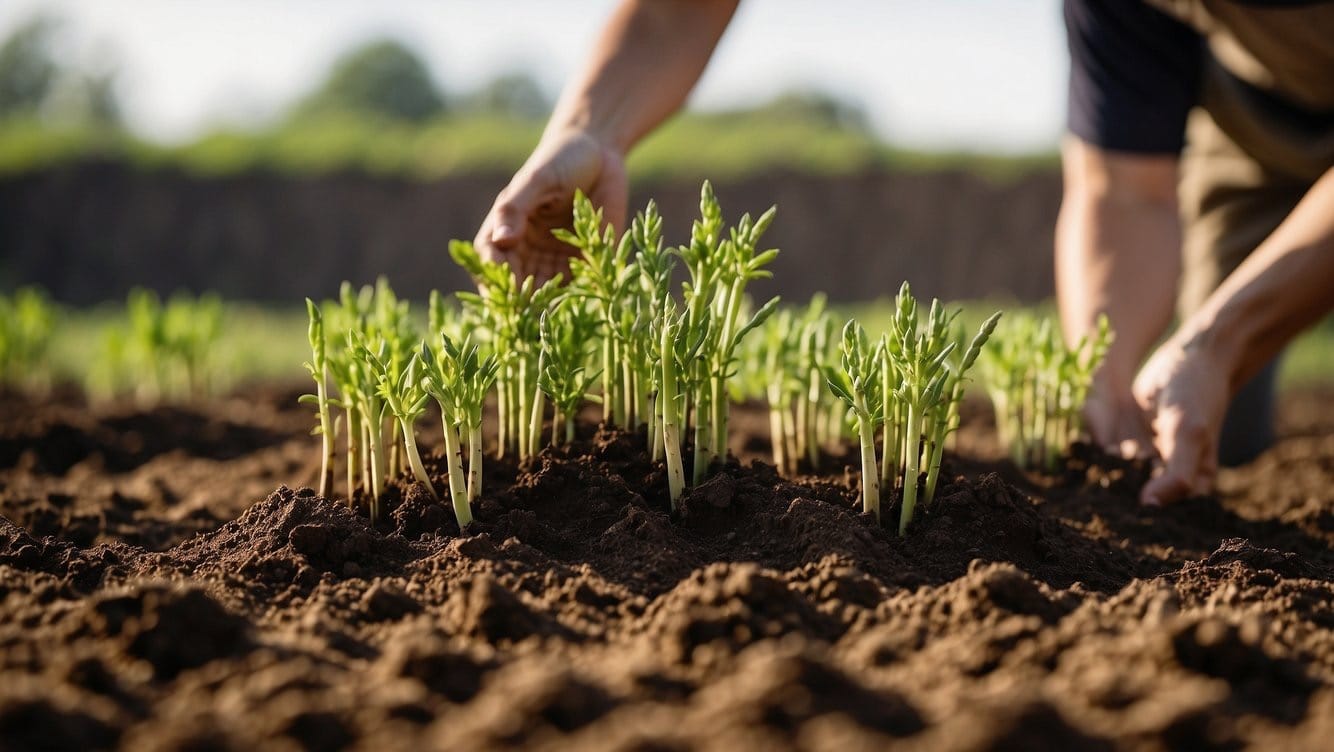
Planting asparagus requires a choice between crowns and seeds and understanding the proper techniques and timing for planting. Achieving a successful crop starts with the initial planting phase.
Choosing Crowns or Seeds
To start your asparagus bed, you have two options: planting one-year-old crowns or starting from seeds.
Crowns are the roots of one-year-old plants and are a popular choice because they tend to establish quicker. They generally produce a harvestable crop in the third year after planting.
If you choose to grow from seeds, expect a longer establishment period of about three to four years before harvest but with potentially less risk of disease carried over from a nursery.
Planting Techniques
When planting asparagus crowns:
- Dig a trench approximately 6 inches deep and 12-18 inches wide.
- Space the crowns 12-18 inches apart, placing them atop a small mound of soil within the trench, spreading the roots around the mound.
- Cover the crowns with soil and water them thoroughly.
If you opt for planting seeds:
- Sow asparagus seeds indoors 12-14 weeks before the last expected frost.
- Plant seeds ¼ to ½ inch deep in individual pots or trays.
- Once seedlings are about 8-10 inches tall and after the last frost, transplant them into your garden.
Timing for Optimal Growth
The best time to plant asparagus is in the early spring, as soon as the soil can be worked.
Whether you’re planting crowns or seeds, make sure to do so after the last expected frost to avoid damage to the plants.
This timing ensures the plants can establish themselves during the growing season and are strong enough to survive the upcoming winter.
Caring for Asparagus Plants
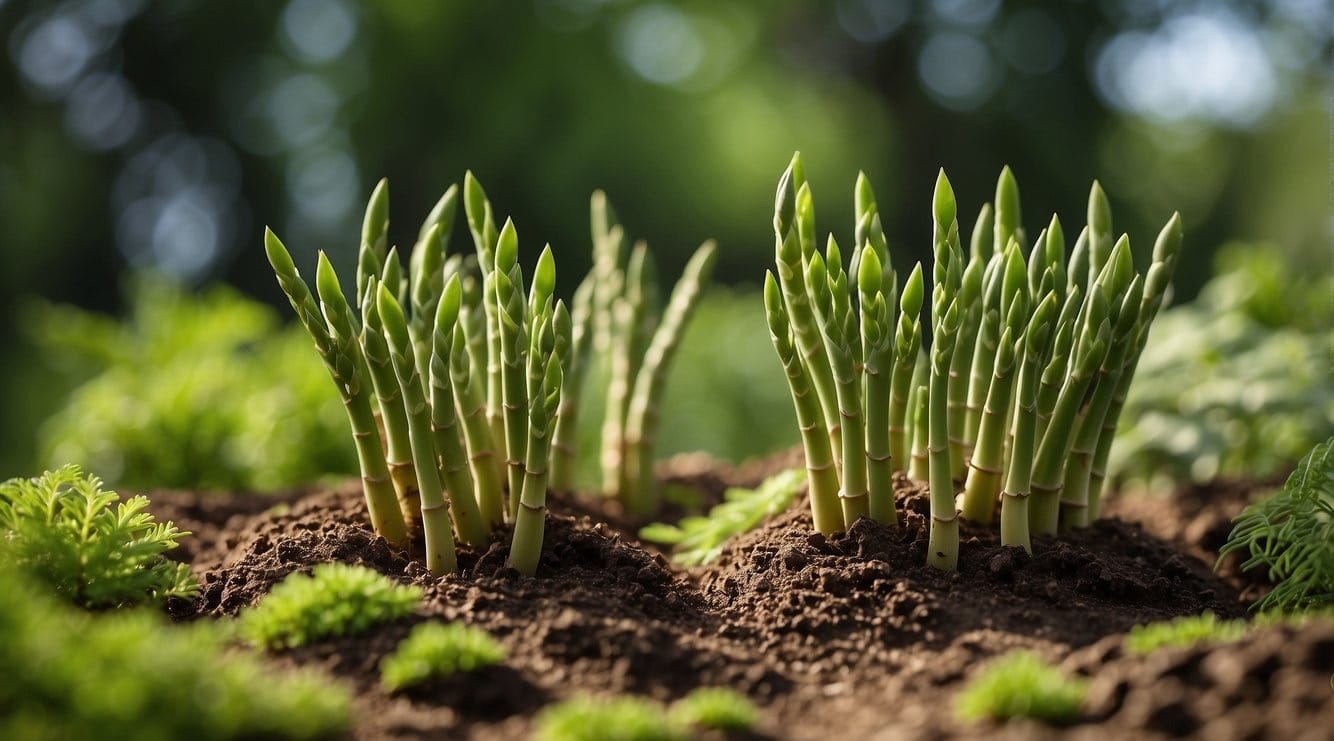
After successfully planting asparagus, the next vital step is to care for the plants properly to ensure a productive crop.
Proper watering, weed control, and nutrient management are essential for healthy asparagus.
Watering Requirements
Asparagus requires consistent watering, especially during the first two years after planting.
- Seedlings: Keep the soil moist but not waterlogged.
- Mature plants: Supply about 1 inch of water per week.
Overhead watering can promote foliar diseases, so use drip irrigation or soaker hoses to deliver water directly to the roots.
Mulching and Controlling Weeds
A well-mulched asparagus bed is crucial for weed control and soil moisture retention.
- Mulch: Apply 2 to 4 inches of organic material like straw or compost.
- Weeding: Hand-pull weeds or use a hoe, being careful not to disturb the asparagus root system.
The presence of weeds competes for nutrients and moisture, so regular weeding is important.
Fertilization and Nutrient Management
Asparagus plants are heavy feeders and need adequate nutrients to thrive.
- Spring: Before spear emergence, apply a fertilizer like 10-10-10 at the rate of 2 pounds per 100 square feet.
- Compost/Manure: Annually, apply a layer of rich compost or well-rotted manure to supply nutrients and improve soil structure.
- Nitrogen: After harvest, applying additional nitrogen can help promote vigorous foliage, which fuels the next season’s growth.
Fighting Pests and Diseases
To ensure a healthy asparagus crop, you need to be vigilant against both pests and diseases.
By identifying common threats and applying the right prevention strategies, you can cultivate a more vigorous and hardy asparagus garden.
Common Pests of Asparagus

One of the main pests affecting asparagus is the asparagus beetle. There are two types: the common asparagus beetle and the spotted asparagus beetle. Here's what to look out for:
- Common Asparagus Beetle: They are characterized by their black body with cream-colored spots. Larvae feed on the spears and foliage, which can reduce yield.
- Spotted Asparagus Beetle: Easier to distinguish with its red body and black spots. Mainly feed on the berries of the asparagus plant.
Control Measures:
- Physical removal: Regularly inspect plants and handpick beetles and larvae.
- Maintain plant vigor: A well-nourished plant can better withstand pest invasion.
- Harvest spears thoroughly: This reduces the habitat for beetles to lay eggs.
Disease Prevention Strategies
Asparagus can be susceptible to a variety of diseases, but with the right strategies, you can greatly reduce their impact:
- Promote good air circulation: Plant asparagus rows in the direction of prevailing winds to encourage airflow. This helps prevent fungal diseases.
- Plant selection: Choose disease-resistant cultivars to reduce the risk of disease.
- Crop rotation: Avoid planting asparagus on the same spot where asparagus or corn has been planted in the last four years to minimize disease risk.
- Soil management: Avoid deep tillage that may damage asparagus crowns and roots.
By focusing on pest and disease prevention, you'll be taking the necessary steps to protect and enhance your asparagus garden's productivity.
Harvesting and Storage
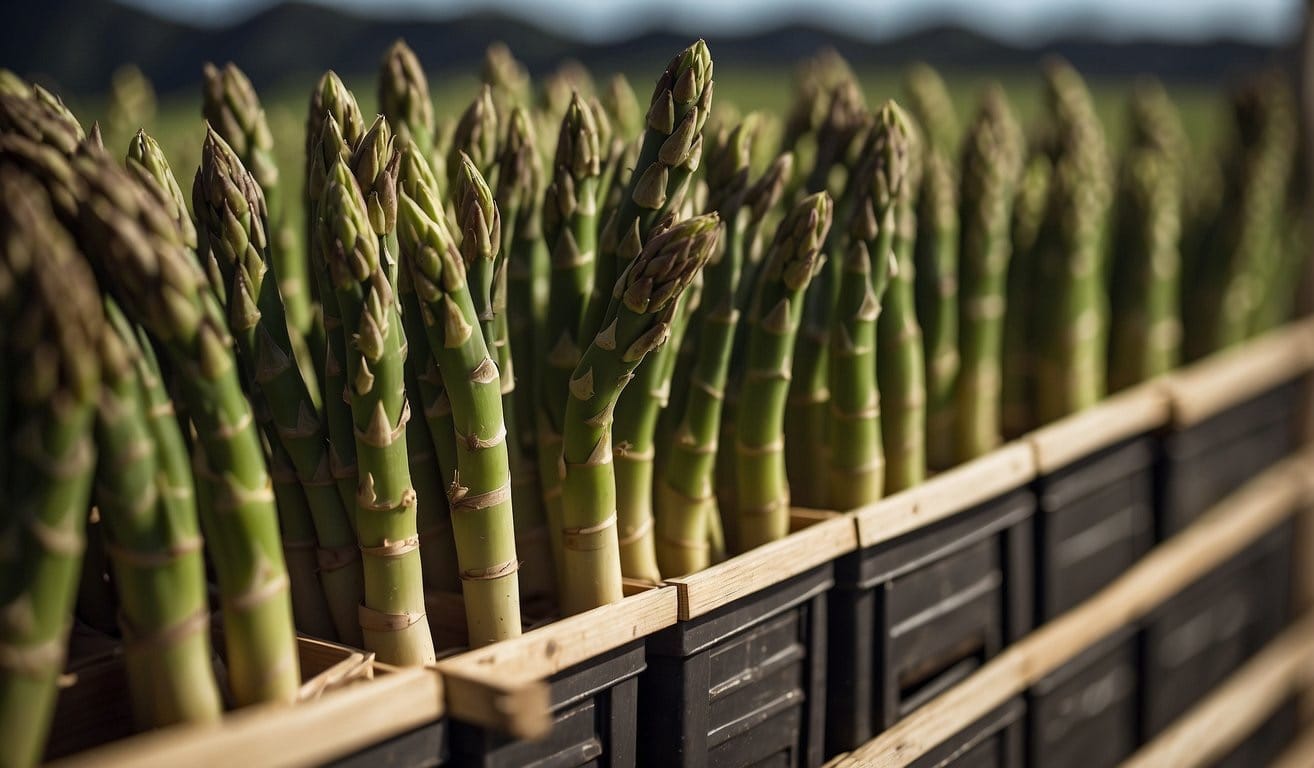
Harvesting asparagus at the right time and storing it properly ensures maximum flavor and shelf life. Here's how you can achieve the best results.
When and How to Harvest Asparagus
You can start harvesting asparagus when the spears are 6 to 10 inches tall and about the thickness of your index finger, typically in the spring.
Cut the spears at ground level using a sharp knife or garden shears, or snap them off with your fingers just above the soil to prevent damage to the emerging shoots.
It's best to carry out this process in the morning or early evening.
Extending the Harvest Season
To extend the harvest period, be attentive to the growth rate. Early in the season, you might harvest every second or third day; as the temperature rises, you may need to harvest once or twice daily.
After the initial harvest season, which can be productive for about 6 to 8 weeks, allow the plants to grow and replenish their energy for the next year.
Storing Asparagus for Freshness
To store asparagus, first immerse the spears in cold water after harvest to cool them rapidly.
Then, wrap the ends in a moist cloth or paper towel and place them in a perforated plastic bag. Store in the refrigerator's vegetable crisper at approximately 36°F (2°C).
This method will keep your asparagus fresh for up to 10 days, maintaining quality and taste.
Maximizing Asparagus Yield
To maximize your asparagus yield, focus on promoting healthy spear production and establishing a robust perennial system that requires long-term, yet manageable, care.
Encouraging Spear Production
To ensure vigorous spear growth in asparagus, timing and method are crucial. Begin by planting your crowns 12 inches apart in a trench, and cover them initially with just a few inches of soil.
As the shoots begin to emerge, gradually fill in the trench. The season plays a role; fertilize your asparagus in late winter or early spring.
Choose a fertilizer rich in potassium and phosphate to encourage productive spear production.
- When to Fertilize: Late winter or early spring, before growth starts
- Fertilizer Type: High in potassium and phosphate
Long-Term Care for Perennial Success
For long-term success, after the harvest season, let the shoots grow into mature ferns. These ferns replenish the plant's energy reserves for the next season.
Maintain fertile soil through annual additions of organic matter. Remember, asparagus is a perennial, and with proper care, it can be productive for 15 years or more.
- Post-Harvest: Allow spears to grow into ferns
- Soil Fertility: Add compost or well-rotted manure annually
Concluding Tips for Asparagus Growers
Growing asparagus requires patience, but your diligence is rewarded with spears that are not only flavorful but also nutritious.
As your asparagus garden matures, you'll note a richer, fuller flavor in your homegrown spears compared to store-bought ones.
- Soil and Planting: Asparagus thrives in well-drained soil. Ensure your bed is prepared with rich, organic matter. When planting crowns, set them in a trench atop a mound of soil, spreading the roots out evenly.
- Spacing: Proper spacing is crucial. Place crowns 12-18 inches apart, allowing ample room for growth.
- Watering: Keep your asparagus bed moist, especially during dry spells. Consistent watering helps in the development of tender spears.
- Feeding: Give your plants a boost with a balanced fertilizer each spring. Asparagus is a heavy feeder and benefits from the nutrients.
- Harvesting: Resist the urge to harvest in the first year. This allows your plants to establish strong root systems. In subsequent years, harvest spears when they are about 6-8 inches tall.
- Maintenance: Eliminate weeds to prevent competition for resources. Applying mulch can aid in this as well as in keeping the soil moist.
Frequently Asked Questions
In this section, you'll find concise, reliable answers to common questions about growing asparagus. These guidelines will help you establish and maintain a thriving asparagus crop.
What is the best method for planting asparagus in a raised bed?
For planting asparagus in a raised bed, ensure that the bed is at least 12-18 inches deep. Prepare a soil mix high in organic matter, and plant 1 to 2-year-old crowns about 6 inches deep, spacing them 12 to 18 inches apart. Initially, cover crowns with 3-4 inches of soil and add more soil gradually as shoots grow.
Can asparagus be propagated from cuttings, and if so, how?
Asparagus is typically not propagated from cuttings. Instead, it's grown from crowns, which are the root systems of mature plants. For propagation, division of these crowns is the most common and effective method, typically performed in early spring.
What steps are necessary to grow asparagus from seeds successfully?
To grow asparagus from seeds, start by planting seeds indoors about 12-14 weeks before the last expected frost. Once seedlings develop and outdoor temperatures are suitable, transplant them into a prepared bed, ensuring proper spacing. It will take an additional year or two to harvest asparagus when started from seed compared to using crowns.
What is the recommended procedure for harvesting asparagus to promote growth?
Begin harvesting asparagus when spears are about 6-8 inches tall and a pencil's thickness. Cut or snap spears above the soil line. In the first year after planting crowns, refrain from harvesting. In the second year, harvest a few spears over a 3-week period, then allow plants to grow to replenish nutrients for the following season.
How long should one expect to wait before harvesting asparagus for the first time?
After planting asparagus crowns, it's generally recommended to wait until the third growing season to start a full harvest. This patience allows the plant to establish a strong root system. If you started from seeds, expect to wait an additional year or two beyond this timeframe.
What are the requirements for growing asparagus in containers for urban gardening?
To grow asparagus in containers, choose a pot that is at least 18 inches deep and wide with good drainage. Make sure to use fertile, well-drained potting mix.
Containers may inhibit the full potential growth due to the perennial nature of asparagus. So, consider this option as more short-term and replace crowns every few years.



